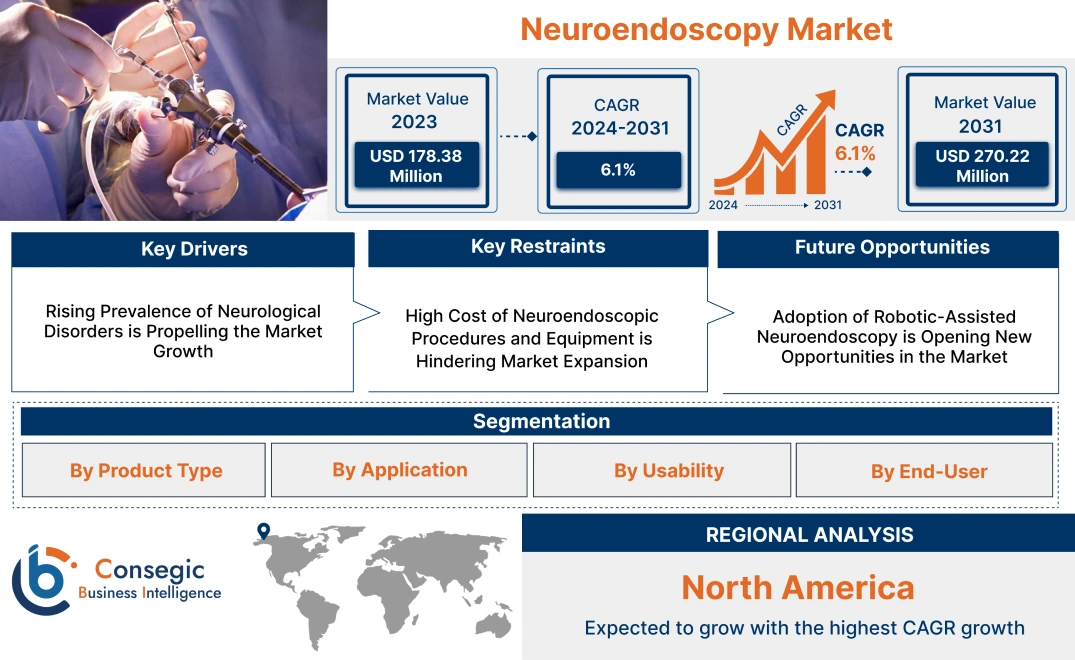Neuroendoscopy Market Size:
Neuroendoscopy Market size is growing with a CAGR of 6.1% during the forecast period (2024-2031), and the market is projected to be valued at USD 270.22 Million by 2031 from USD 178.38 Million in 2023.
Neuroendoscopy Market Scope & Overview:
Neuroendoscopy is a minimally invasive surgical technique used to diagnose and treat conditions within the brain and spinal cord. It involves the use of a thin, flexible tube with a camera and light source, called an endoscope, which is inserted through small openings or natural body passages. This approach allows neurosurgeons to visualize internal structures, remove tumors, drain cysts, and address other neurological issues without the need for large incisions. The benefits include reduced recovery time, less postoperative pain, and a lower risk of complications compared to traditional open surgery. It's commonly used for procedures involving the ventricles of the brain, such as in the treatment of hydrocephalus, as well as for biopsies and the management of certain types of brain tumors. Neuroendoscopy, end users refer to the primary groups or individuals who directly benefit from the procedure such as patients, neurosurgeons, healthcare providers, medical researchers, and device manufacturers.
How is AI Transforming the Neuroendoscopy Market?
AI is transforming the neuroendoscopy market by improving pre-operative planning, enhancing intra-operative precision with image analysis and real-time guidance, and accelerating post-operative outcomes through predictive analytics. AI algorithms analyze endoscopic images to accurately identify and characterize brain tumors, aneurysms, and other pathologies. Also, AI integrates with AR to provide real-time, enhanced surgical navigation, improving tumor identification and surgical guidance. Further, AI-powered image analysis helps diagnose conditions and differentiate between various neurological disorders as well as assists in assessing disease activity, providing more standardized and accurate evaluations.
Neuroendoscopy Market Dynamics - (DRO) :
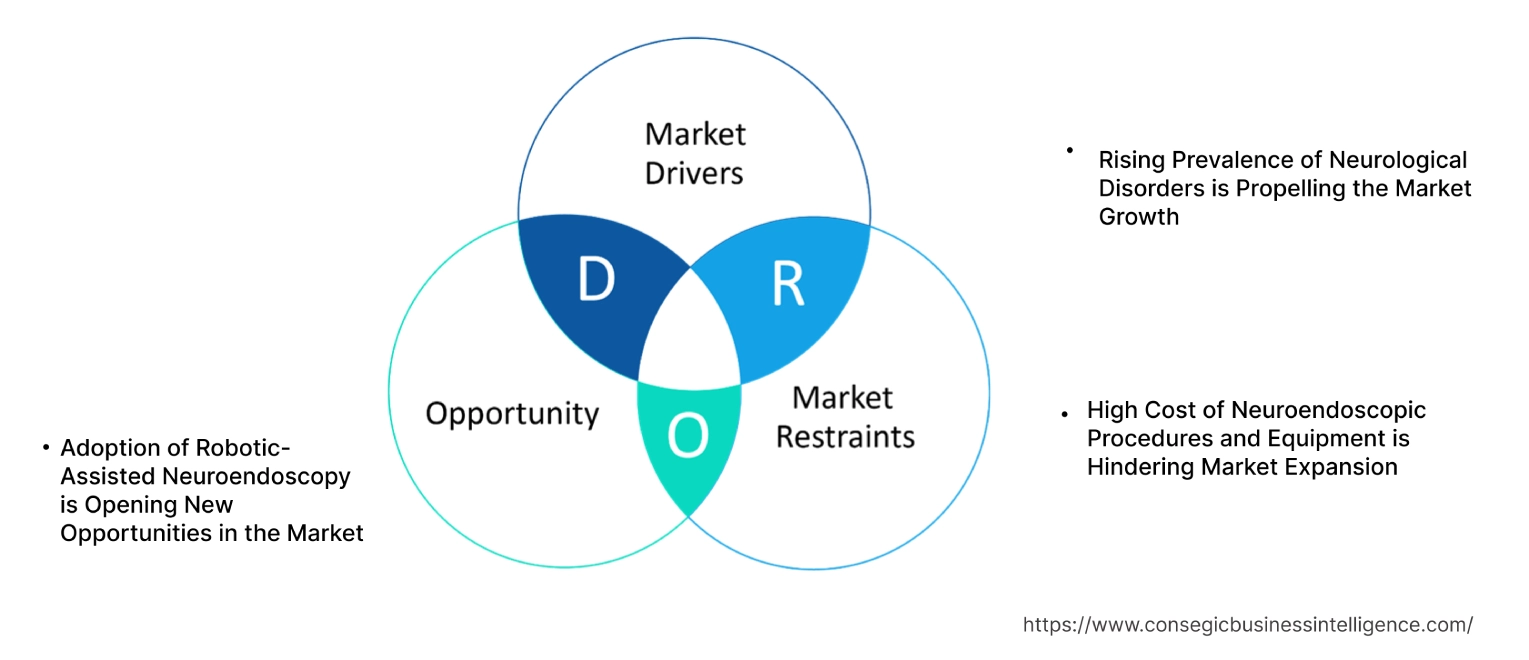
Key Drivers:
Rising Prevalence of Neurological Disorders is Propelling the Market Growth
Neurological conditions like brain tumors, hydrocephalus, and cysts become more common, and there's a growing demand for neuroendoscopic procedures that offer less invasive options, leading to quicker recovery and reduced hospital stays. The increasing prevalence drives innovation in neuroendoscopic equipment and techniques, with manufacturers developing more sophisticated endoscopes, imaging systems, and tools that enhance surgical outcomes. With the growing burden of neurological disorders, healthcare systems are likely to invest more in neuroendoscopic technologies and training for neurosurgeons, further expanding the market.
- In July 2023, as per Weill Cornel Medicine endoscopes serve as small microscopes, magnifying critical anatomical structures so the surgeon can easily see the various diseased areas requiring repair, removal, or replacement.
Therefore, the rising prevalence of neurological disorders is a key driver fostering advancements in technology and expanding access to innovative treatments, thus, boosting the neuroendoscopy market growth.
Key Restraints :
High Cost of Neuroendoscopic Procedures and Equipment is Hindering Market Expansion
Neuroendoscopic instruments and devices are often expensive, which can limit access to hospitals, particularly in low- and middle-income regions. The initial investment required for advanced technology can deter healthcare facilities from adopting these procedures. The overall cost of neuroendoscopic surgeries, including anesthesia, operating room time, and postoperative care, is relatively high, making it less accessible for patients and healthcare providers. Economic downturns or budget cuts in healthcare lead to reduced spending on advanced surgical technologies, further limiting the availability of neuroendoscopic services.
- In 2022, according to the Iranian Journal of Neurosurgery the cost of 4K grade neuroendoscope systems is extremely high. As a result, the demand for high-resolution imaging equipment in this surgical operation justifies the use of GoPro-sized cameras in underdeveloped nations with limited medical resources.
Therefore, challenges such as the high costs of procedures and equipment, limited insurance coverage, and the need for specialized training must be addressed to maximize access and adoption, restraining the neuroendoscopy market demand.
Future Opportunities :
Adoption of Robotic-Assisted Neuroendoscopy is Opening New Opportunities in the Market
Robotic systems will offer greater precision in surgical procedures, allowing neurosurgeons to navigate complex anatomical structures more effectively, which can lead to improved outcomes. It will provide opportunities for simulation-based training for neurosurgeons, improving their skills and confidence in performing neuroendoscopic procedures. Partnerships between medical institutions and technology firms will drive innovation, leading to the development of new robotic platforms and tools tailored for neuroendoscopy.
- In 2024, World Laparoscopy Hospital states that AI has the potential to significantly improve procedural results and decision-making in robotic surgery. Artificial intelligence (AI) algorithms will help surgeons in real time by providing insights based on large datasets and enhancing robotic systems.
Therefore, the future of neuroendoscopy is promising, particularly with the integration of robotic-assisted technologies. This advancement not only enhances surgical precision and reduces invasiveness but also opens up new applications, creating neuroendoscopy market opportunities.
Neuroendoscopy Market Segmental Analysis :
By Product Type:
Based on product type the market is segmented into Rigid Neuro endoscopes and Flexible Neuro endoscopes.
Trends in the Type:
- Integration in optics and instrumentation have made rigid neuro endoscopes even more appealing to healthcare providers, increasing their market presence.
- Manufacturers are introducing next-generation flexible neuroendoscopes with enhanced features like fiber-optic illumination, real-time navigation systems, and multi-angle articulation.
The Rigid Neuro endoscopes accounted for the largest revenue share of the total neuroendoscopy market share in the year 2023.
- Rigid neuroendoscopes are commonly used in a variety of neurosurgical procedures, particularly for the treatment of hydrocephalus, intraventricular tumors, and brain cysts. They are the standard for endoscopic third ventriculostomy and other minimally invasive procedures, which are frequently performed in both adult and pediatric patients.
- Surgeons often prefer rigid neuroendoscopes because they offer a solid, steady platform for accessing the brain's ventricular system or other intracranial areas, reducing the risk of unintended movements during surgery.
- For instance, Indiamart's Ss Neuro Rigid Endoscopy Instrument which is frequently utilized for a variety of inspection and measurement tasks. It is put together with high-quality optic lenses that offer amazing contrast.
- Thus, the rigid neuroendoscopes segment accounted for the largest revenue share due to its widespread use in neurosurgery, cost-effectiveness, and ability to provide high-quality visualization during minimally invasive procedures, driving the neuroendoscopy market growth.
The Flexible Neuro endoscopes segment is anticipated to register the fastest CAGR during the forecast period.
- Flexible neuroendoscopes are highly valued for their ability to navigate difficult-to-reach areas of the brain with minimal disruption to surrounding tissue.
- Recent innovations in fiber-optic technology, miniaturization, and high-definition imaging have significantly improved the performance of flexible neuroendoscopes.
- Flexible neuroendoscopes are increasingly being utilized in emerging applications such as robotic-assisted surgeries, where the flexibility and precision of these devices complement the dexterity and control offered by robotic systems. This integration of technologies is driving further growth in the flexible segment.
- For instance, novel robotic platforms provide a pathway to smaller surgical robots using a variety of technologies, including functioning flexible endoscopes.
- Thus, the flexible neuroendoscopes segment is expected to register the fastest due to increasing demand for minimally invasive neurosurgical procedures, advancements in technology, and their expanding use in complex brain surgeries, boosting the neuroendoscopy market opportunities.
By Application:
Based on application the market is segmented into Transnasal Neuro endoscopy, Intraventricular Neuro endoscopy, and Transcranial Neuro endoscopy.
Trends in the Application:
- Enhanced visualization capabilities allow surgeons to navigate the ventricular system with greater accuracy, improving surgical outcomes and further boosting the adoption of intraventricular neuroendoscopy.
- Integration of robotics and AI is enhancing the accuracy of transcranial endoscopy further driving revenue for the market.
The Intraventricular Neuro endoscopy application accounted for the largest revenue share of the overall neuroendoscopy market share in the year 2023.
- Neuroendoscopy is frequently used to access and remove intraventricular tumors and cysts, which are located deep within the brain's ventricular system.
- The minimally invasive nature of the procedure allows for precise access to these areas without the need for large craniotomies, contributing to its popularity and revenue dominance.
- The use of intraventricular neuroendoscopy has been associated with improved patient outcomes, including shorter hospital stays, faster recovery, and reduced complication rates compared to traditional methods.
- Continuous advancements in neuroendoscopic technology, particularly in high-definition imaging, fiber optics, and intraoperative navigation systems, have made intraventricular procedures more precise and safer.
- For instance, in treating intracranial aneurysms and brain tumors, the surgical method has been used to treat anterior skull base disorders such as frontal lobe brain contusion and laceration, cerebrospinal fluid rhinorrhea, with promising outcomes.
- Thus, the benefits of minimally invasive surgery, combined with technological advancements and widespread adoption in both adult and pediatric populations, have made intraventricular neuroendoscopy the leading segment in the market, driving the neuroendoscopy market demand.
The Transcranial Neuro endoscopy segment is anticipated to register the fastest CAGR during the forecast period.
- Transcranial neuroendoscopy involves accessing the brain through small openings in the skull, allowing for the treatment of complex intracranial conditions with minimal tissue disruption.
- Significant improvements in high-definition imaging, endoscopic cameras, and surgical instruments have made transcranial neuroendoscopy more precise and effective.
- Transcranial is associated with smaller incisions, reduced risk of infection, less blood loss, and faster recovery times compared to traditional open brain surgery. These advantages are driving its use in a broader range of neurosurgical procedures.
- For instance, the pituitary and skull base are accessible through endonasal endoscopic methods using the B Braun transnasal endoscopic system MINOP TREND.
- Thus, with its ability to offer safer, less invasive treatment options and better patient outcomes, transcranial is becoming a preferred technique in neurosurgical centers worldwide, boosting the neuroendoscopy market trends.
By Usability:
Based on usability the market is segmented into Reusable Neuro endoscopes and Disposable Neuro endoscopes.
Trends in the Usability:
- Ongoing improvements in the design, imaging capabilities, and flexibility of reusable neuro endoscopes have made them more versatile and effective, allowing for high-quality visualization during surgeries.
- Innovation in disposable endoscopes, such as the incorporation of advanced imaging technology and flexible designs, is driving growth in this segment.
The Reusable Neuro endoscopes application accounted for the largest revenue share in the year 2023.
- Reusable neuroendoscopes, although initially more expensive than disposable ones, can be used multiple times, making them a more cost-efficient option in the long term. Hospitals and clinics often prefer reusable devices as they help reduce overall operational costs, especially in facilities with a high volume of neuroendoscopic procedures.
- Improved sterilization processes have made it safer and easier to reuse neuro endoscopes without the risk of infection or contamination. This has increased confidence in the use of reusable devices and contributed to their market dominance.
- As sustainability becomes a growing concern in the healthcare industry, many institutions are opting for reusable devices to reduce medical waste.
- Thus, this segment is expected to continue holding a significant share of the market as the demand for minimally invasive neurosurgical procedures grows, driving the neuroendoscopy market expansion.
The Disposable Neuro endoscopes segment is anticipated to register the fastest CAGR during the forecast period.
- The growing awareness of hospital-acquired infections (HAIs) and the need to minimize the risk of cross-contamination are major drivers for the adoption of disposable neuro endoscopes.
- Disposable neuroendoscopes offer significant advantages in terms of time savings and convenience. With no need for sterilization or maintenance, they allow for quicker preparation between surgeries, which is especially important in high-volume settings.
- As outpatient and ambulatory surgical centers (ASCs) continue to expand, they opt for disposable neuroendoscopes due to lower upfront costs, reduced need for sterilization infrastructure, and faster turnaround between procedures.
- For instance, the Centre for Medicare and Medicaid Services recently approved a transitional pass-through payment by creating a new category and new HCPCS C-codes specific for single-use duodenoscopes and ureteroscopes.
- Thus, the disposable segment is poised for rapid growth, fueled by rising concerns over infection control, the expansion of outpatient care, and improvements in disposable device technology, boosting the neuroendoscopy market trends.
By End-User:
Based on end-user the market is segmented into Hospitals, Ambulatory Surgical Centers (ASCs), Specialty Clinics, and Research Institutes.
Trends in the End-User:
- Hospitals are often early adopters of advanced medical technologies, such as robotic-assisted neuroendoscopy, which enhances precision and outcomes.
- Continuous improvements in neuroendoscopic devices including better visualization tools, flexible scopes, and enhanced camera systems have placed specialty clinics at the forefront for adopting the advancement at the earliest.
The hospital's application accounted for the largest revenue share of 39.81% in 2023.
- Hospitals handle the majority of complex neurosurgeries, including brain tumor resections, hydrocephalus treatment, and skull base surgeries, which frequently require neuroendoscopy. The sheer volume of these surgeries conducted in hospitals drives significant demand for neuroendoscopic systems and tools.
- Hospitals provide comprehensive care, including pre-operative imaging, surgery, and post-operative care, making them the preferred settings for patients requiring neuroendoscopic procedures. Their ability to offer a full spectrum of services supports their leading position in the market.
- For instance, Amrita Hospital in Kochi has established Kerala's first Centre for Neuro Endoscopy (ACNE) for patients with neurological and neurosurgical problems.
- Thus, hospitals, as the primary centers for advanced neurosurgery, continue to account for the largest revenue share in the market.
The Ambulatory Surgical Centers (ASCs) segment is anticipated to register the fastest CAGR during the forecast period.
- ASCs are increasingly being used for minimally invasive surgeries, including neuroendoscopic procedures, which involve smaller incisions, reduced recovery times, and fewer complications.
- Advancements in neuroendoscopic techniques and tools, have led to neurosurgical procedures that once required lengthy hospital stays can now be performed in outpatient settings like ASCs. This shift towards outpatient neurosurgery is fueling demand for neuroendoscopy in ASCs.
- The development of smaller, portable, and cost-effective neuroendoscopic devices has made it easier for ASCs to adopt the new technology.
- For instance, according to the Canadian Journal of Surgery the use of ASCs ensures that doctors who intend to work at these facilities continue to have on-call responsibilities at their home hospital. Having ASCs associated with a hospital will also enable resource sharing and give ASC patients a place to go if they need to be admitted to the hospital.
- Thus, the ASC segment is expected to grow rapidly due to its ability to provide cost-effective, minimally invasive neuroendoscopic procedures in an outpatient setting.
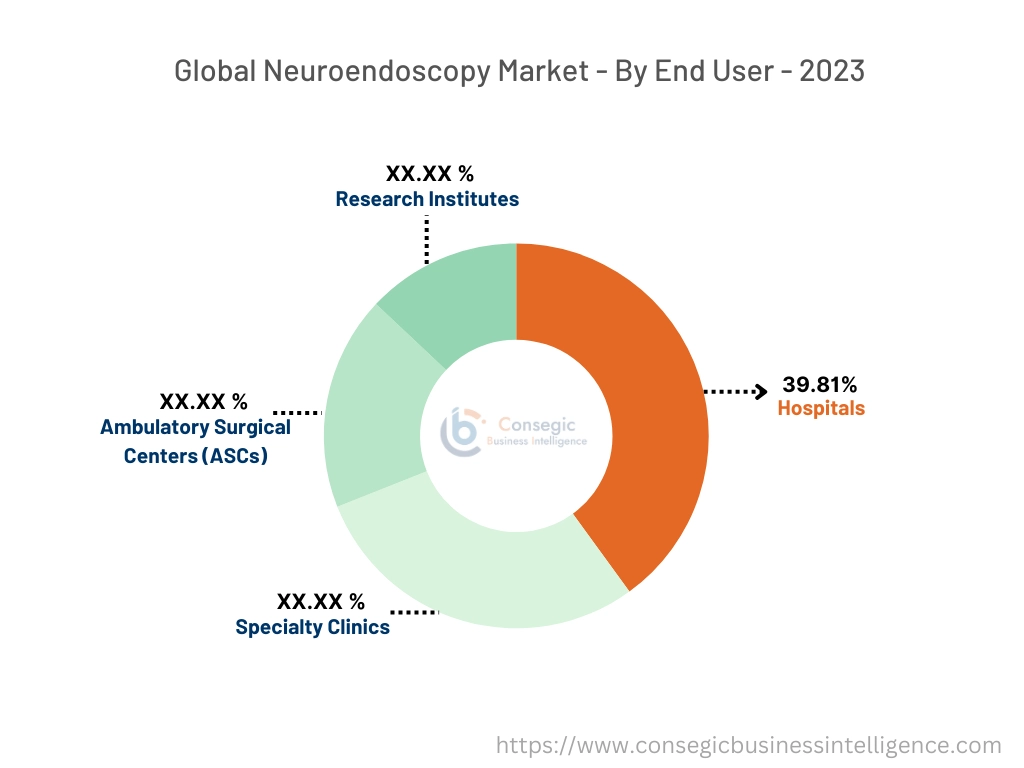
Regional Analysis:
The regions covered are North America, Europe, Asia Pacific, the Middle East and Africa, and Latin America.
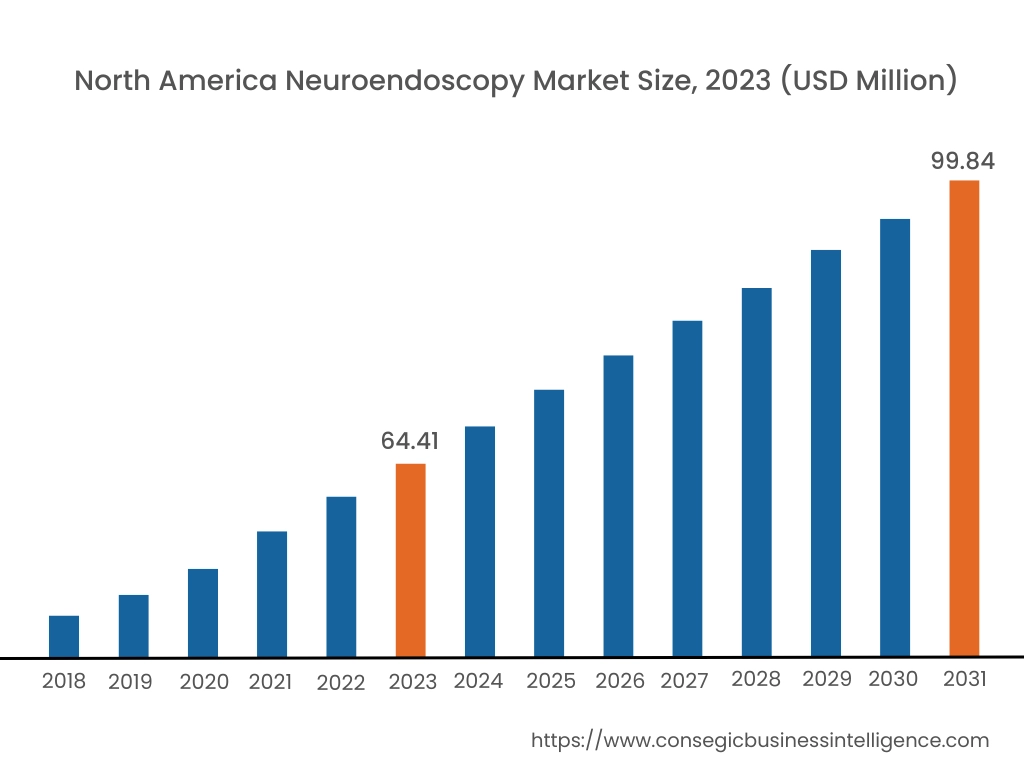
In 2023, North America accounted for the highest market share at 36.11% and was valued at USD 64.41 Million, and is expected to reach USD 99.84 Million in 2031. In North America, the U.S. accounted for the highest market share of 68.14% during the base year of 2023. As per the neuroendoscopy market analysis, North America, particularly the United States, has one of the most advanced healthcare systems globally, with top-tier hospitals and medical centers offering cutting-edge neurosurgical procedures. This infrastructure enables the adoption of the latest neuroendoscopic technologies, contributing to market growth.
- In March 2023, the Ambulatory Surgical Centers are increasingly being used in the United States to conduct ambulatory interventions, these operations are typically performed in major, full-service hospitals in Canada. Numerous scientific studies, including one from Canada's largest publicly financed ASC, have verified that ASCs are a safe place for patients to have surgery.
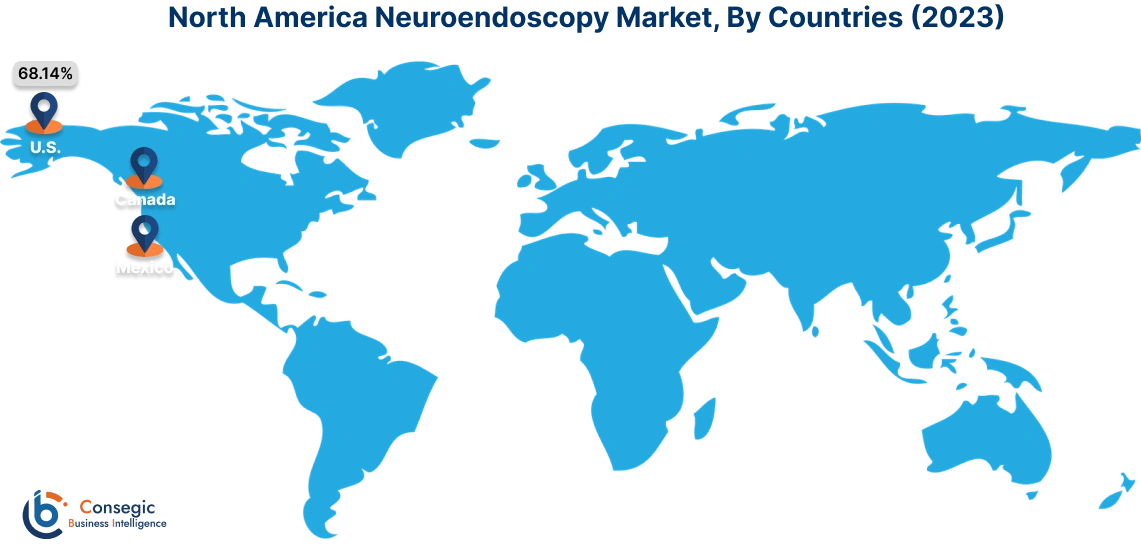
Asia Pacific is expected to witness the fastest CAGR over the forecast period of 6.8% during 2024-2031. The Asia-Pacific market is poised for substantial growth in the coming years due to the increasing demand for minimally invasive neurosurgical procedures, the rising prevalence of neurological disorders, and advancements in medical infrastructure. Countries such as China, India, Japan, and South Korea are leading the neuroendoscopy market expansion.
- For Instance, MINOP is a new intraventricular neuro-endoscopic system from B Braun that is mainly intended for the treatment of intraventricular indications including occlusive hydrocephalus and the excision of cysts and tumors.
The neuroendoscopy market analysis shows that Europe is home to some of the world's leading medical device companies, such as Karl Storz (Germany), that are at the forefront of developing cutting-edge neuroendoscopic equipment. Countries such as Germany, France, the UK, and Italy are leading the market as there is a constant growth of specialized neurological centres and they even adopt advanced neuroendoscopic techniques for complex treatments.
The Middle East and Africa's health sector is gradually improving, with governments and private sector players investing in modern hospitals and clinics. This is particularly true in wealthier countries like the UAE and Saudi Arabia, which are making significant strides in adopting advanced medical technologies.
The Latin American market is experiencing gradual growth, driven by increasing healthcare investments, rising awareness of minimally invasive surgical techniques, and improvements in medical infrastructure.
Top Key Players & Market Share Insights:
The Neuroendoscopy market is highly competitive with major players providing services to the national and international markets. Key players are adopting several strategies in research and development (R&D), product innovation, and end-user launches to hold a strong position in the global neuroendoscopy market. Key players in the Neuroendoscopy industry include-
- Karl Storz SE & Co. KG (Germany)
- B. Braun Melsungen AG Ltd (Germany)
- Zeiss Group (Germany)
- HAWK Endoscopy Instruments (Germany)
- Schindler Endoskopie Technologie GmbH (Germany)
- Medtronic plc (Ireland)
- Stryker Corporation (USA)
- Olympus Corporation (Japan)
- Ackermann Instrumente GmbH (Germany)
- Adeor Medical AG (Germany)
Recent Industry Developments :
Partnerships and Collaborations:
- In September 2023, Duomed is SonoScape's only endoscopic partner in the Netherlands. This relationship aligns perfectly with their aim of providing entire solutions as a partner to hospitals and private clinics, supplying products and services that satisfy the highest quality standards in medical care.
Product Launch:
- In October 2023, Olympus launched the EVIS X1 endoscopy system. Physicians utilize Olympus GI endoscopy devices to diagnose, treat, and monitor diseases and disorders of the upper and lower GI tracts, including acid reflux, ulcers, Crohn's disease, Celiac disease, and colon cancer.
Neuroendoscopy Market Report Insights :
| Report Attributes | Report Details |
| Study Timeline | 2018-2031 |
| Market Size in 2031 | USD 270.22 Million |
| CAGR (2024-2031) | 6.1% |
| By Product Type |
|
| By Application |
|
| By Usability |
|
| By End-User |
|
| By Region |
|
| Key Players |
|
| North America | U.S. Canada Mexico |
| Europe | U.K. Germany France Spain Italy Russia Benelux Rest of Europe |
| APAC | China South Korea Japan India Australia ASEAN Rest of Asia-Pacific |
| Middle East and Africa | GCC Turkey South Africa Rest of MEA |
| LATAM | Brazil Argentina Chile Rest of LATAM |
| Report Coverage |
|
Key Questions Answered in the Report
How big is the Neuroendoscopy Market? +
Neuroendoscopy Market size is growing with a CAGR of 6.1% during the forecast period (2024-2031), and the market is projected to be valued at USD 270.22 Million by 2031 from USD 178.38 Million in 2023.
What is the key market trend? +
The key market trend is that the integration of robotics and AI is enhancing the accuracy of transcranial endoscopy which is further driving revenue for the market.
What specific segmentation details are covered in the neuroendoscopy market report? +
The specific segments that are covered in the neuroendoscopy market are product type, application, usability, and end-user.
Who are the major players in the neuroendoscopy market? +
The major players in the neuroendoscopy market are Karl Storz SE & Co. KG (Germany), B. Braun Melsungen AG Ltd (Germany), Medtronic plc (Ireland), Stryker Corporation (USA), Olympus Corporation (Japan), Ackermann Instrumente GmbH (Germany), Adeor Medical AG (Germany), Zeiss Group (Germany), HAWK Endoscopy Instruments (Germany), and Schindler Endoskopie Technologie GmbH (Germany).
